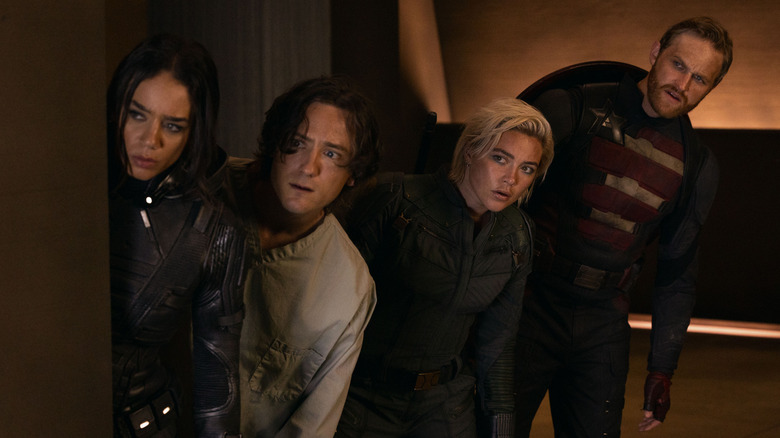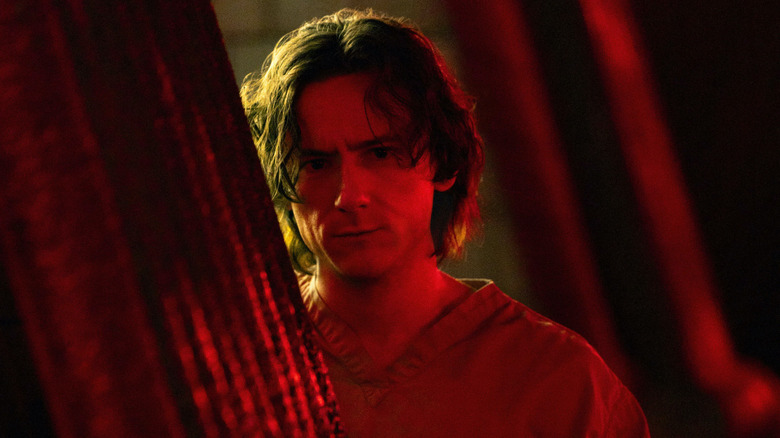Marvel Had To Make One Change To Sentry's Thunderbolts Story Due To Spider-Man
"Thunderbolts*" establishes Bob, aka Sentry (Lewis Pullman), as one of the most powerful beings in the Marvel Cinematic Universe. While he ultimately defeats his villainous alter ego, The Void, and sides with the titular superteam, the morally conflicted supe still seems like he's one bad mood swing away from destroying the world. After all, Sentry's powers and abilities eclipse those of all of the Thunderbolts combined, and his temperament makes him unpredictable and dangerous. That said, he's sympathetic due to his tragic backstory: a drug addict who was used as a disposable lab rat by a company trying to manufacture superheroes. His origin story in the comics is different, but ended up being changed for the movie — because "Spider-Man: No Way Home" got to it first.
In an interview with Marvel, "Thunderbolts*" director Jake Schreier revealed that he was inspired by Paul Jenkins and Jae Lee's "Sentry" #1 while making the movie. In his first Marvel Comics appearance, Bob is introduced as a middle-aged, married amnesiac who suddenly remembers his past life as a mighty superhero. That isn't a good thing, though, because the Void — the villainous part of his persona — is a real nightmare to deal with.
It's an interesting premise, but "Spider-Man: No Way Home" explores a similar concept when Doctor Strange (Benedict Cumberbatch) erases the memories of everyone who knows Peter Parker (Tom Holland) to prevent the Multiverse from imploding. Schreier wanted his film to stand out on its own, so "Thunderbolts*" goes in another direction, but Jenkin and Lee's comic book still inspired him in other ways.
Thunderbolts* embraces Sentry's meta origins
Sentry's introduction to Marvel Comics is one of history's great marketing stunts. The publisher advertised the character as a "lost" concept created by Stan Lee and Artie Rosen in the 1960s — one that never made it to print. Marvel used its editorials and the media to manipulate readers into believing the character's fake behind the scene's history, before admitting it was all a ploy and Paul Jenkins was the real creator.
What's more, Jenkins and Jae Lee's series inserts Sentry into the events of old comics, adding a meta element to the saga. This inspired Jake Schreier, who felt "Thunderbolts*" needed its own meta magic. This is on display in the scene where the corrupt politician Valentina Allegra de Fontaine (Julia-Louis Dreyfus) unveils her plans for Sentry. As the director explained:
"So much of the meta of the movie is trying to create a Super Hero. I thought, 'Well, that's what [Marvel] does.' So, in that scene where Bob is learning to use his powers and they're building a suit behind him, all of that stuff comes from our actual costume department. And there's a 3D printer from [property master] Russell Bobbitt. We're doing the same thing that Val is doing in the movie, so that was our little nod to the meta idea of how we represent Super Heroes."
While Schreier didn't get to fully embrace Sentry's original backstory, he at least got to pay homage to his weird and wacky history. And the version of Sentry we meet in "Thunderbolts*" could become an influential part of the MCU going forward, proving that the changes the film makes to the character are worthwhile in their own right.

